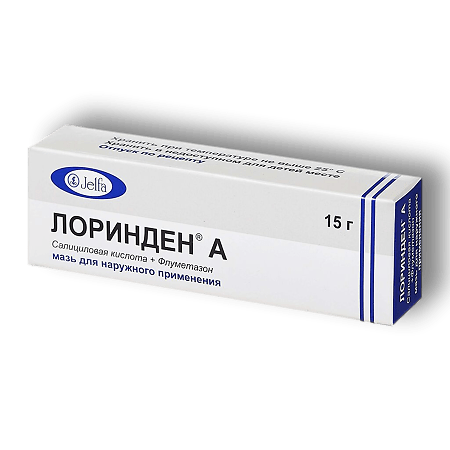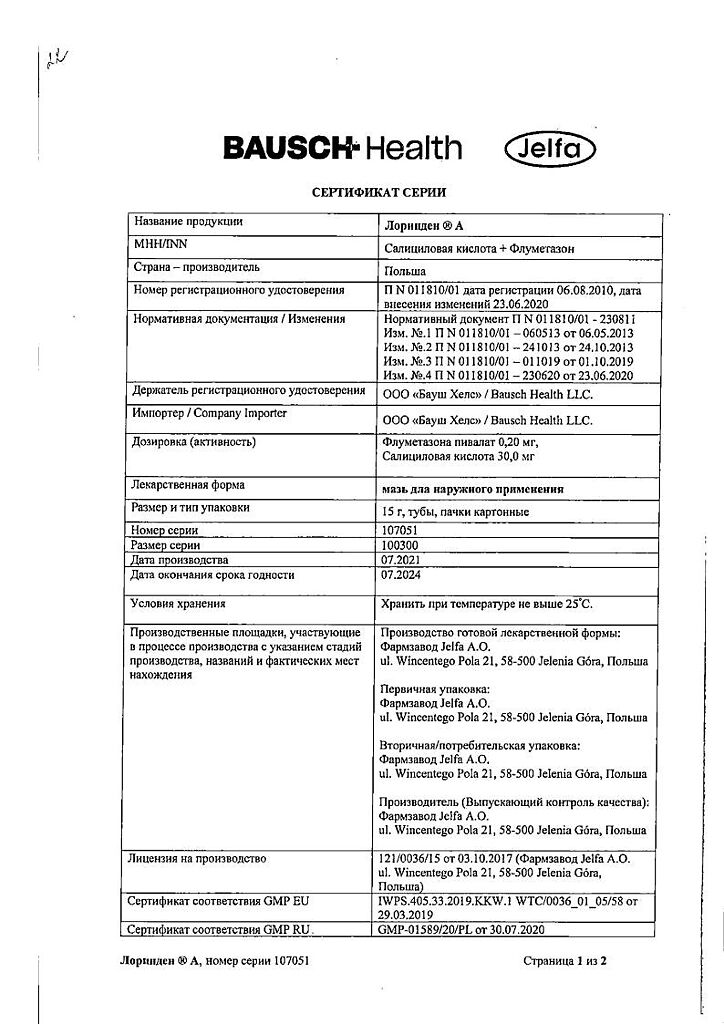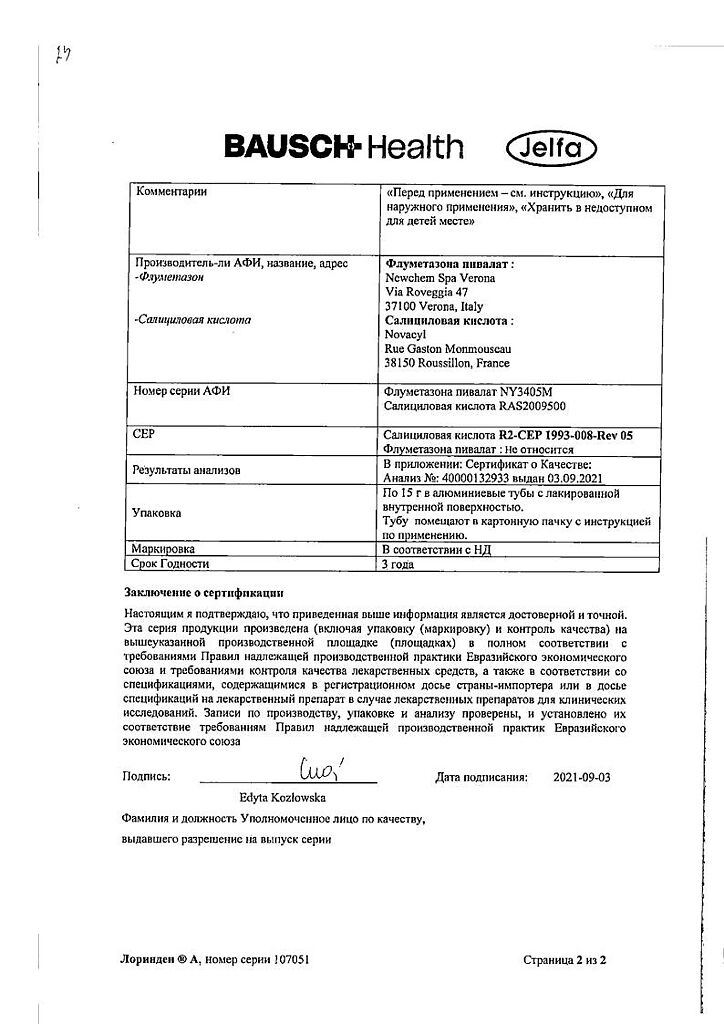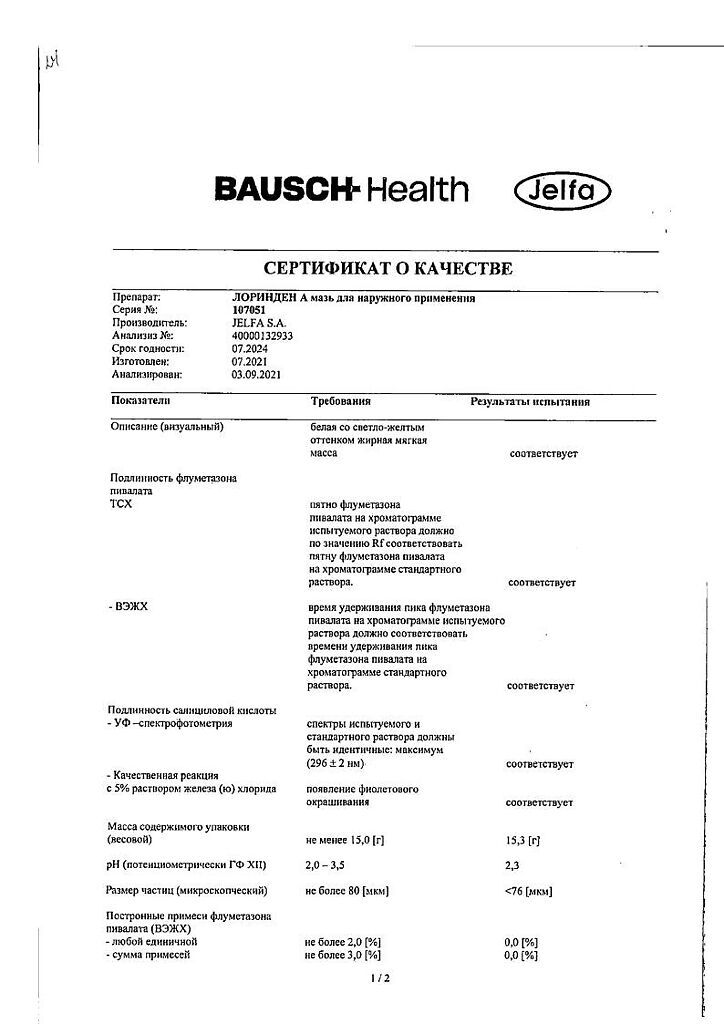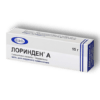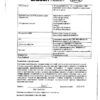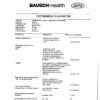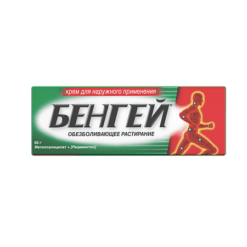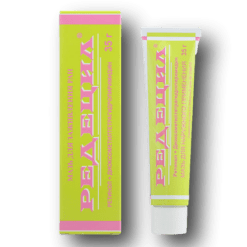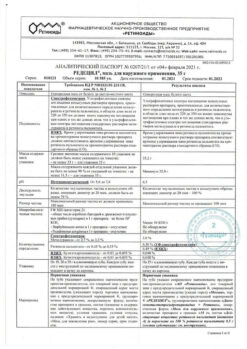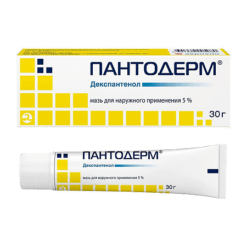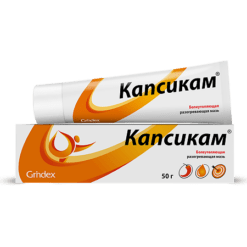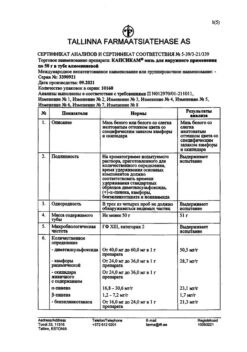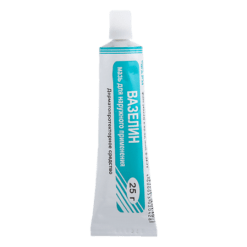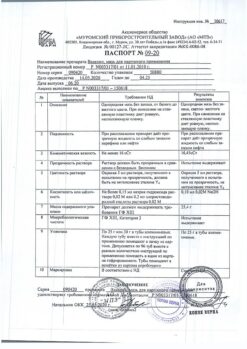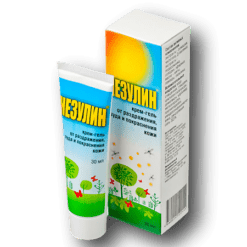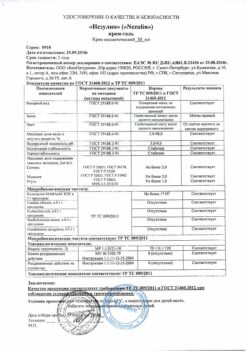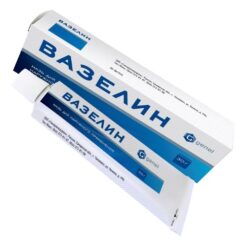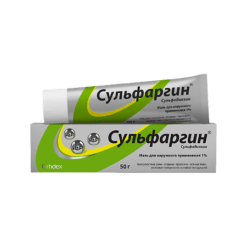No products in the cart.
Lorinden A, ointment 15 g
€16.76 €13.97
Description
Lorinden A is a combined drug with anti-inflammatory and keratolytic action for external use.
Flumetasone pyvalate is a synthetic GKS, it has anti-inflammatory, anti-edema, anti-allergic, antipruritic effects. It inhibits the activity of phospholipase A2, which leads to suppression of the synthesis of prostaglandins and leukotrienes, inhibits the release of inflammatory mediators.
Inhibits migration of leukocytes and lymphocytes to the center of inflammation. It prevents marginal accumulation of neutrophils, which leads to decrease of inflammatory exudate, cytokines production and inhibition of macrophages migration, as a result the infiltration and granulation processes are reduced. It inhibits proteolytic activity of tissue kinins, inhibits the growth of fibroblasts, prevents the development of connective tissue in the inflammation focus. It reduces hyperemia, manifestations of hypersensitivity reactions, proliferative and exudative processes in the connective tissue in the focus of inflammation.
Salicylic acid, an NSAID, promotes penetration of GCS and gives the drug additional antiparokeratotic, moderate keratolytic and local hypothermic properties, promotes penetration of flumetasone into the skin. In addition, it has antibacterial and fungicidal action and restores the protective function of the skin. It suppresses the secretion of sebaceous and sweat glands.
Pharmacokinetics
Absorption
Absorption of flumetasone pivalate is higher in children than in adults and is increased when applied to the skin folds, face, skin with damaged epidermis and inflammatory skin, under occlusive dressings, when applied to large areas of skin (in which case it may have systemic action).
Distribution
Because of the external route of administration and the keratolytic action of salicylic acid, flumethasone pyvalate easily penetrates the stratum corneum of the skin, through the keratinized layers of the skin, where it cumulates.
Metabolism
Flumetasone pyvalate is virtually unmetabolized in the skin. After minor absorption into the systemic bloodstream, flumetasone pivalate is biotransformed in the liver.
Elimination
Extracted in the urine and, to a lesser extent, in the bile in the form of compounds with glucuronic acid, as well as in small quantities unchanged.
Indications
Indications
Lorinden A ointment is prescribed for:
eczema – subacute or chronic;
diffuse neurodermatitis;
atopic dermatitis;
hyperkeratosis;
psoriasis
chronic dyshidrosis;
lichen planus;
seborrhea;
photodermatitis;
prurigo with lichenification;
blistering skin diseases;
red verrucous verrucous;
discoid lupus erythematosus;
exudative erythema;
insect bites.
Pharmacological effect
Pharmacological effect
Lorinden A is a combined drug with anti-inflammatory and keratolytic effects for external use.
Flumethasone pivalate is a synthetic corticosteroid that has anti-inflammatory, decongestant, antiallergic, and antipruritic effects. Inhibits the activity of phospholipase A2, which leads to suppression of the synthesis of prostaglandins and leukotrienes, inhibits the release of inflammatory mediators.
Inhibits the migration of leukocytes and lymphocytes to the site of inflammation. Prevents the marginal accumulation of neutrophils, which leads to a decrease in inflammatory exudate, cytokine production and inhibition of macrophage migration, as a result of which the processes of infiltration and granulation are reduced. Inhibits the proteolytic activity of tissue kinins, retards the growth of fibroblasts, and prevents the development of connective tissue at the site of inflammation. Reduces hyperemia, manifestations of hypersensitivity reactions, proliferative and exudative processes occurring in the connective tissue at the site of inflammation.
Salicylic acid is an NSAID, promotes the penetration of corticosteroids and gives the drug additional antiparakeratotic, moderate keratolytic and local hypothermic properties, promotes the penetration of flumethasone into the skin. In addition, it has an antibacterial and fungicidal effect, and also restores the protective function of the skin. Suppresses the secretion of sebaceous and sweat glands.
Pharmacokinetics
Suction
Absorption of flumethasone pivalate is higher in children than in adults and increases when used in the area of skin folds, on the face, on skin with damaged epidermis and skin affected by inflammation, under occlusive dressings, when used on large areas of skin (in this case it may have a systemic effect).
Distribution
Due to the external route of application and the keratolytic action of salicylic acid, flumethasone pivalate easily penetrates into the stratum corneum of the skin, through the keratinized layers of the skin, where it accumulates.
Metabolism
Flumethasone pivalate is practically not metabolized in the skin. After slight absorption into the systemic circulation, flumethasone pivalate is biotransformed in the liver.
Removal
It is excreted in the urine and, to a lesser extent, in bile in the form of compounds with glucuronic acid, as well as in small amounts unchanged.
Special instructions
Special instructions
Lorinden A is an adequate drug for the treatment of lesions on dry and defatted areas of the skin, characterized by severe infiltration, lichenification, desquamation and hyperkeratosis, as well as callus; It applies easily, adheres well to dry skin, increases its fat content and promotes moisture retention. The degree of moisturizing can be adjusted by the thickness of the applied layer, in accordance with the therapeutic requirements specific to each individual case.
It is contraindicated to apply the drug to the skin of the face. It is necessary to ensure that the drug does not come into contact with the mucous membranes and conjunctiva.
It is not recommended to exceed the course of treatment. With prolonged use of the ointment over large areas of skin, the incidence of side effects increases.
If an infection occurs at the site of application of the ointment, products with a more pronounced antibacterial or antifungal effect should be used.
It should be used with caution in persons with atrophic skin changes, especially in elderly patients.
The ointment does not contaminate clothes and bedding.
– Use for impaired renal function Repeated application to large areas of skin should be avoided in patients with severe renal failure (systemic effects of salicylic acid are possible).
– Use in pediatrics In children, the drug is used only if absolutely necessary, for a short course, on small surfaces of the body.
– Impact on the ability to drive vehicles and operate machinery
The drug does not limit psychophysical activity, the ability to drive vehicles or maintain moving mechanisms.
Active ingredient
Active ingredient
Salicylic acid, Flumethasone
Composition
Composition
1 g of ointment for external use contains:
Active substances:
flumethasone pivalate 200 mcg,
salicylic acid 30 mg.
Excipients:
propylene glycol,
lanolin anhydrous,
Vaseline white.
Contraindications
Contraindications
It is not recommended to use the drug in patients suffering from:
bacterial, fungal and viral skin lesions;
skin tuberculosis;
exudative stages of skin diseases;
syphilis with skin manifestations;
precancerous conditions and skin tumors;
acne.
In addition, you should refrain from using the ointment at the beginning of pregnancy, with trophic ulcers from varicose veins, with hypersensitivity and in childhood. Caution requires treatment of patients diagnosed with renal failure, since the danger of the nephrotoxic effect of significant doses of salicylates remains.
Side Effects
Side Effects
Local reactions: possible – burning, itching, dry skin; with long-term use – skin atrophy, local hirsutism, telangiectasia, purpura, steroid acne, perioral dermatitis, pigmentation disorders.
Systemic reactions: with long-term use, application to large areas of skin and/or use of occlusive dressings, side effects characteristic of GCS are possible.
When using the drug Lorinden A externally on the skin of the eyelids, in the future, sometimes, the development of cataracts or glaucoma is possible.
Interaction
Interaction
During treatment with the drug, vaccinations and immunizations are contraindicated due to the immunosuppressive effect of the drug.
Should not be prescribed in combination with other drugs for external use.
With systemic absorption of the drug, GCS reduces the effect of insulin, oral hypoglycemic agents, antihypertensive drugs, anticoagulants, and reduces the concentration of praziquantel in the blood serum.
The combination of Lorinden A with the following drugs increases the risk of side effects: androgens, estrogens, oral contraceptives, anabolic steroids (hirsutism, acne), antipsychotics, bucarban, azathioprine (cataracts), anticholinergics, antihistamines, tricyclic antidepressants, nitrates (glaucoma), diuretics (hypokalemia), cardiac glycosides (digitalis intoxication).
Overdose
Overdose
Symptoms: extremely rarely, when used on very large areas of the skin, systemic manifestations of GCS and/or symptoms of salicylate poisoning are possible.
Storage conditions
Storage conditions
The drug should be stored at a temperature not exceeding 25°C.
Shelf life
Shelf life
3 years.
Manufacturer
Manufacturer
Pharmaceutical plant Elfa A.O., Poland
Additional information
| Shelf life | 3 years. |
|---|---|
| Conditions of storage | The drug should be stored at a temperature not exceeding 25 ° C. |
| Manufacturer | Jelfa Pharmzavod, Poland |
| Medication form | topical ointment |
| Brand | Jelfa Pharmzavod |
Related products
Buy Lorinden A, ointment 15 g with delivery to USA, UK, Europe and over 120 other countries.

